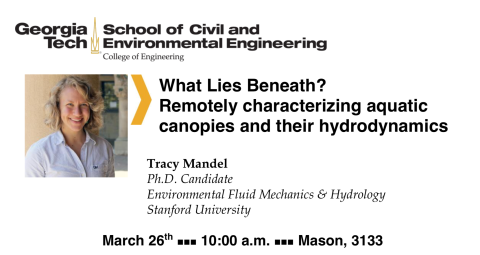event
Seminar: Ph.D. Candidate Tracy Mandel
Primary tabs
Tracy Mandel, Ph.D. Candidate, Environmental Fluid Mechanics Laboratory - Stanford University
Research Interests:
- Coastal Hazards and Protection
- Near-shore Hydrodynamics
- Turbulent Canopy Flow
"What Lies Beneath? Remotely characterizing aquatic canopies and their hydrodynamics"
Abstract
Seagrasses, kelp, and corals alter the flow of fluid through and around them at many scales, from individual blades and branches to the entire meadow or forest. A community of these organisms, collectively called a “canopy,” can engineer and interact with their environment to optimally uptake nutrients, disperse seeds, and improve water clarity. These organisms also provide many benefits to humans by reducing shoreline erosion, dampening waves, and even producing natural biocides that kill pathogens in the water. As engineers, how do we measure and detect the ecosystem services that aquatic organisms provide?
In this talk, I will present an illustrative example of a classic canopy flow, and the novel quantitative imaging techniques that we can use in the lab to study it. Under unidirectional flow, submerged canopies generate a hydrodynamic instability, sending coherent vortices spinning downstream. These fluid structures can impact the water surface, suggesting that a canopy may leave a “footprint” on the water surface that could yield clues to the canopy’s size and geometry (vegetation height, density, etc.). This footprint manifests itself as a series of small perturbations in the water surface slope that have an optical signature. We obtain snapshots of the water surface slope over time, showing the emergence of these vortices at the water surface, their propagation downstream, and the length scale of the structures. This imaging method yielded important insights into how the speed and size of the vortices depends on the properties of the vegetation, suggesting that the subsurface hydrodynamics can be predicted by measuring the water surface behavior.
We are working towards understanding how the inherent frequency, length scale, and propagation speed of these fluid structures depend on ecosystem configuration, density, and submergence, in order to better understand the flow through and around aquatic ecosystems. These same surface expressions may be detectable in the field using existing remote sensing techniques. Additionally, this laboratory technique holds promise for many other questions, including the effects of vegetation on wave shape, and properties of surface turbulence from more generalized bottom roughness.
Status
- Workflow Status:Published
- Created By:Emanuele Di Lorenzo
- Created:03/23/2018
- Modified By:Emanuele Di Lorenzo
- Modified:03/23/2018
Categories
Keywords
Target Audience

